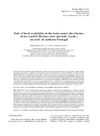Identificador persistente para citar o vincular este elemento:
https://accedacris.ulpgc.es/jspui/handle/10553/57431
| Título: | Role of food availability in the bathymetric distribution of the starfish "Marthasterias glacialis" (Lamk.) on reefs of northern Portugal | Otros títulos: | Efecto de la disponibilidad alimentaria sobre la distribución batimétrica de la estrella de mar "Marthasterias glacialis" (Lamk.) en arrecifes del norte de Portugal | Autores/as: | Tuya Cortés, Fernando Duarte, Pedro |
Clasificación UNESCO: | 2401 Biología animal (zoología) | Palabras clave: | Starfish Vertical distribution Segregation Food availability Spatial patterns, et al. |
Fecha de publicación: | 2012 | Editor/a: | 0214-8358 | Publicación seriada: | Scientia Marina | Resumen: | We examined whether the abundance and size of the starfish Marthasterias glacialis (Lamk.) exhibit a depth-dependent partitioning on subtidal reefs. We tested the hypothesis that differences in food availability can result in habitat partitioning along a depth gradient. The abundance and size of M. glacialis was registered at 4 depth strata: 0-4 m, 4-8 m, 8-12 m, and >12 m; we also recorded the number of food items that they were preying on. The abundance and size of M. glacialis decreased with depth. Mussels (Mytilus galloprivincialis) were the most preyed food item across all depth strata, followed by gastropods, sea urchins and barnacles; M. glacialis also consumed a significantly larger amount of mussels in feeding experiments compared with sea urchins and gastropods. The abundance of M. galloprivincialis beds decreased with depth. The clear link between the decrease in abundance and size of M. glacialis with depth and the decay of the most consumed prey (mussels) suggest that food availability may play an important role in the vertical distribution of this starfish, though wave-associated turbulence in the first few metres of the subtidal could also limit the abundance of M. glacialis. Examinamos si la abundancia y talla de la estrella de mar Marthasterias glacialis (Lamk.) exhibe una segregación batimétrica en arrecifes submareales. Contrastamos el modelo que predice que diferencias en la disponibilidad alimenticia puede resultar en una segregación del hábitat a lo largo de un gradiente batimétrico. La abundancia y talla de M. glacialis se registró sobre 4 estratos de profundidad: 0-4 m, 4-8 m, 8-12 m, y>12 m; además registramos el número de presas sobre las que estaban depredando. La abundancia y talla de M. glacialis decreció con la profundidad. Los mejillones (Mytilus galloprivincialis) fueron la presa más consumida, seguido de gasterópodos, erizos de mar y cirrípedos; M. glacialis también consumió una cantidad significativamente superior de mejillones en experiencias alimentarias en relación a erizos de mar y gasterópodos. La clara asociación entre la caída en profundidad de la abundancia y talla de M. glacialis y la caída de su presa más consumida (mejillones) sugiere que la disponibilidad alimentaria juega probablemente un papel importante en la distribución vertical de esta estrella de mar. No obstante, individuos marcados mostraron un movimiento a corto plazo mayor sobre un estrato somero que sobre un estrato profundo, y por tanto, la turbulencia asociada al oleaje en los primeros metros del medio submareal también pudiera afectar el patrón ecológico de M. glacialis con la profundidad. |
URI: | https://accedacris.ulpgc.es/handle/10553/11437 https://accedacris.ulpgc.es/handle/10553/57431 |
ISSN: | 0214-8358 | DOI: | 10.3989/scimar.2012.76n1009 | Fuente: | Scientia Marina [ISSN 0214-8358], v. 76 (1), p. 9-15 | Derechos: | by-nc-nd | URL: | http://dialnet.unirioja.es/servlet/articulo?codigo=5290311 |
| Colección: | Artículos |
Los elementos en ULPGC accedaCRIS están protegidos por derechos de autor con todos los derechos reservados, a menos que se indique lo contrario.
